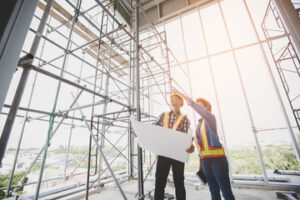Whether you’re planning a new construction project or a complete renovation, general contractors (also known as GCs) are the professionals who can make your build happen. GCs are responsible for the day-to-day oversight of a project, management of vendors and trades, and communicating with all involved parties.

GCs are typically contracted from start to finish on projects, while subcontractors get hired on shorter durations. This exposes GCs to different property exposures. Visit Website to learn more.
Whether it’s wielding a carpentry hammer or plumbing the pipework, subcontractors are the fuel powering construction projects. They’re the backbone that helps project managers keep the entire team moving forward – a task that requires effective communication, collaboration and a shared vision of success.
A general contractor’s relationship with their subcontractors begins with the bidding process. GCs curate a list of pre-qualified specialty contractors, and then evaluate them by reviewing past performance, safety ratings, references and financial stability. They also establish benchmarks for quality standards to ensure alignment with the project’s goals and requirements.
The GC will then create a cost proposal to submit to the client. This requires the GC to perform quantity takeoffs and develop detailed scheduling, labor and material estimates. The GC will include all of the project requirements, including budgets for materials, equipment rental, labor, office space, worker’s compensation, liability insurance and other expenses.
On a jobsite, the GC will often involve all of the trade partners in planning sessions and collaborative problem-solving, as well. The use of pull planning, a team scheduling technique, fosters this partnership and allows all of the unique skill sets to converge on a common goal: successful project delivery.
A GC will likely also implement a system that includes regular inspections and continuous monitoring of subcontractors to ensure consistent, high-quality work. This can help minimize legal disputes, financial discrepancies and operational disruptions on a project.
Finally, a GC will manage the payment cycle by ensuring that the property owner sends payments to the correct tier of contractors. This is crucial, as delays in the process can lead to project overruns that put everyone at risk.
The ability to oversee multiple aspects of a large construction project, from the foundational infrastructure to the finished details, is a requirement for any general contractor. In addition to strong leadership and communication skills, a general contractor must be proficient at project planning, scheduling, construction management and safety. Many GCs start out as a field contractor and learn these skills through on-the-job experience. Others pursue educational programs in construction science, building science, surveying and construction safety.
Managing the Project
When working with a general contractor, it’s important to plan out each task before beginning work. This will help reduce or eliminate scope creep and make it easier to track project progress throughout construction. It’s also an opportunity to clarify who does what for the project and establish any steps that require management or stakeholder approval. This will help avoid any misunderstandings down the road and ensure that all parties are aware of what is expected of them.
The first step in managing a construction project involves bidding the job to contractors. The bidding process varies by project type, delivery method and other factors. For example, if the project is being built using a lump-sum contract, the contractor will set one price for the entire project and will only be paid when the build is complete. The owner will then choose a contractor through either an open or closed bid process. Open bidding is typically used for public projects and allows all bidders to submit a proposal. Closed bidding is often reserved for specialized projects that require a high level of expertise or knowledge.
Once the general contractor is selected, the preconstruction phase begins. This is when the GC or construction manager will lay the groundwork for construction, including securing any necessary permits and obtaining project equipment. They will also assess the constructability of the design and work with the architecture and engineering teams to ensure that the final product will meet the project goals and objectives.
At this stage, the GC or construction manager will evaluate and select subcontractor partners and engage in contract negotiations with them. Once the project is underway, the CM will continue to monitor the GC’s performance and make sure that it adheres to the contract stipulations and the owner’s wishes.
In addition to ensuring that the GC or CM is performing their duties, the CM will provide regular reports to the project team and stakeholders to keep everyone updated on project progress. This will help ensure that the GC is on schedule and that the project is staying within budget. It will also help to prevent costly mistakes that could halt the construction timeline or cause other issues on the project.
Managing the Budget
A construction project’s budget is an integral piece of the overall build process. It helps define and prioritize tasks for crews, provides a framework for project milestones and expectations, and gives the client insight into expected costs for their home.
It is important to note that the project budget is only as accurate as the estimating process behind it. As such, it is essential that general contractors use data-driven estimates to craft their budgets, and continue to monitor their progress throughout the project for any cost variances that could affect final pricing for homebuyers.
The first step in creating a budget is to examine the bidding documents and project plans to estimate building costs. These include hard and soft costs, which are the monetary investments in the project that can be tracked and measured. Hard costs include materials, labor and professional services. Soft costs, on the other hand, include miscellaneous expenses that are not tied to a specific task or activity, such as office utilities, productivity software, and safety supplies.
Often, the biggest variable in the construction budget is labor. This includes tradespeople and subcontractors, as well as payroll, taxes, vacation, and sick time. It is also important to take into account the local labor market and wage rates when estimating labor costs, as this can drastically affect the cost of a project.
After establishing the initial budget, it is important to sit down with the client and walk through the numbers with them. This is a great opportunity to explain the thought process that went into each number and work through any objections.
Change orders can wreak havoc on budgets, so it’s crucial to address them quickly and effectively. Be sure to communicate how the changes impact your budgetary and cash flow needs, as well as how you can find creative solutions to help keep everyone on track. Additionally, utilize a tool that allows you to organize and manage change orders to minimize disruptions to the build schedule.
Managing the budget can be challenging, but it’s essential for general contractors to get it right in order to deliver quality projects on time and within their targeted price range. By ensuring that all the necessary elements are included in a construction budget, and monitoring progress throughout the project, general contractors can keep costs down for their clients.
Managing the Schedule
A strong construction schedule is a critical piece to managing the scope of a project. It provides a framework for completion and gives you the physical, human and financial resources you need to do your part. It also lets you provide proper project takeoffs and estimates when bidding for contracts, increasing your chances of winning the contract.
As a general contractor, it is your responsibility to manage the construction schedule on your projects. This involves scheduling crews, identifying materials, communicating with the project team and coordinating with other specialty contractors on site. It also requires you to track upcoming milestones and deadlines and manage the effects of delays on the schedule.
One way to improve your scheduling is to use a Critical Path Method (CPM). This identifies the sequence of tasks that must be completed in order to reach milestones and complete the project. It is used to plan and control the construction of a commercial building or facility, and is an important tool for planning, tracking progress, and estimating project delivery dates.
Managing the schedule also includes creating a Work Breakdown Structure and Gantt chart for your project. This helps you identify and allocate the resources needed to perform the task, including labor, equipment, and materials. It also allows you to establish relationships between tasks and determine if any overlap or duplication is occurring. For example, you may find that drywall installation can be performed concurrently with roofing, but that underlayment installation should precede laying shingles, since they are dependent on each other to protect and seal the roof.
Another important aspect of managing the schedule is to create a realistic estimate of how long it will take to perform each task. This can be done by reviewing similar past projects and seeking updated prices, availability, and lead times from vendors. It is also important to factor in any seasonal or site-specific factors that could affect the pace of work.
Lastly, you must keep your project on budget. This is especially important if you are working with a completion-based payment, where the project owner or GC withholds payments until the project reaches substantial completion. This is a common payment method for construction projects, but it is very challenging to manage when there are delays in the critical path.


 A properly functioning chimney must contain combustion products and vent them outside safely. A poorly functioning chimney can pose a danger to you and your family, so it is vital to have it checked out by a qualified professional. If your flue liner is old or in poor condition, it is important to have it replaced. There are several options for relining your chimney, depending on the size of your existing liner and the overall condition of your flue.
A properly functioning chimney must contain combustion products and vent them outside safely. A poorly functioning chimney can pose a danger to you and your family, so it is vital to have it checked out by a qualified professional. If your flue liner is old or in poor condition, it is important to have it replaced. There are several options for relining your chimney, depending on the size of your existing liner and the overall condition of your flue.